Mental Health Nursing: Mental Health Issues and Patient Care Plan
VerifiedAdded on 2023/06/18
|8
|2550
|398
Homework Assignment
AI Summary
This assignment solution delves into various aspects of mental health nursing, addressing critical issues such as the high rates of mental illness among Indigenous Australians and the associated challenges in accessing treatment. It explores the differences and similarities between schizophrenia and bipolar disorder, discusses the effectiveness of restrictive practices in healthcare, and examines the side effects, indications, monitoring, and consumer education related to Clozapine medication. The solution also provides guidance on managing alcoholism, addressing psychotic conditions, and utilizing therapeutic approaches like Cognitive Behavioral Therapy and Hypnotherapy. Furthermore, it outlines key questions for assessing a patient's mood, identifies nursing priorities in acute inpatient units, and discusses the impacts of mental illness stigma on consumers and their families. Desklib offers a platform to access this and many other solved assignments to aid in your studies.
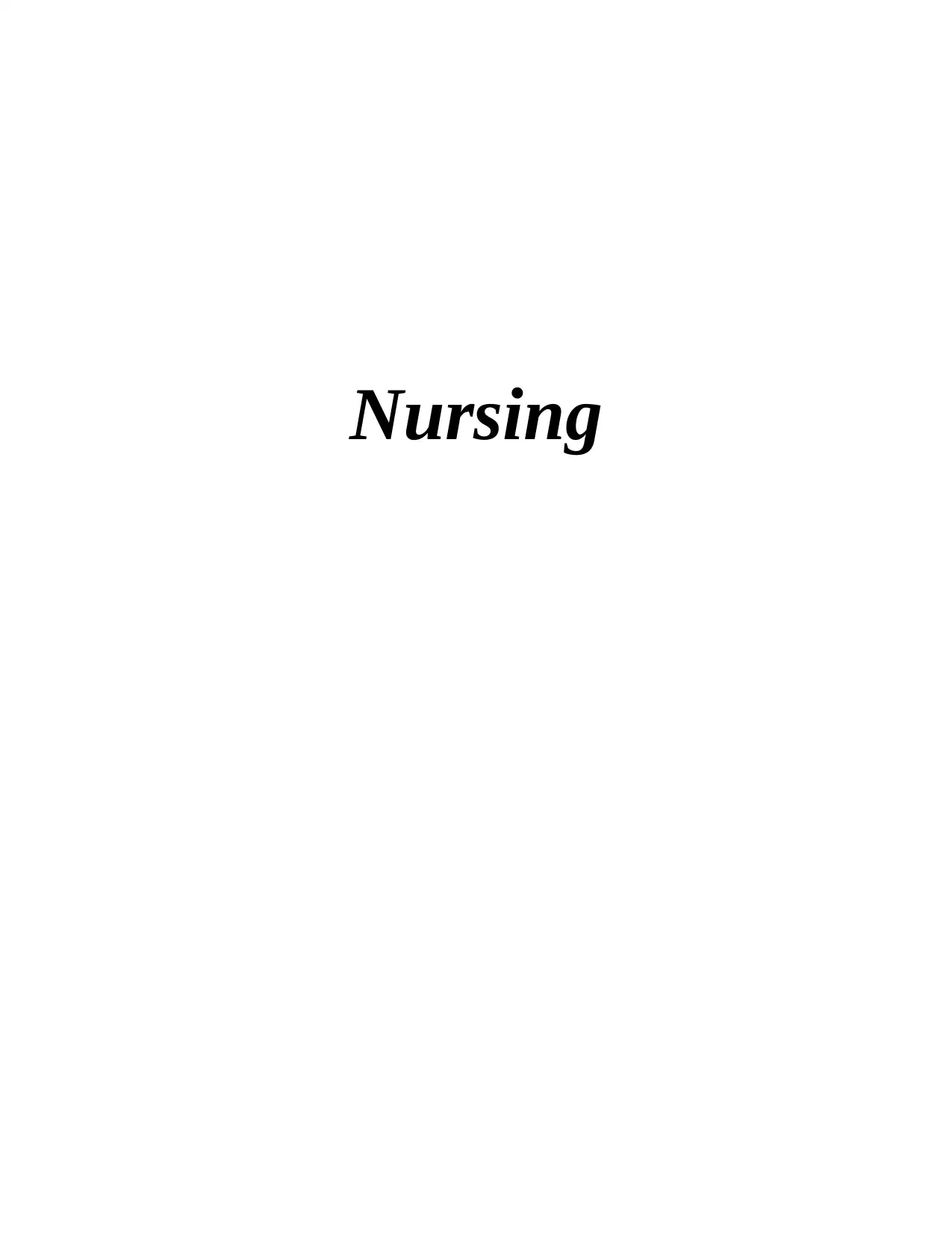
Nursing
Paraphrase This Document
Need a fresh take? Get an instant paraphrase of this document with our AI Paraphraser
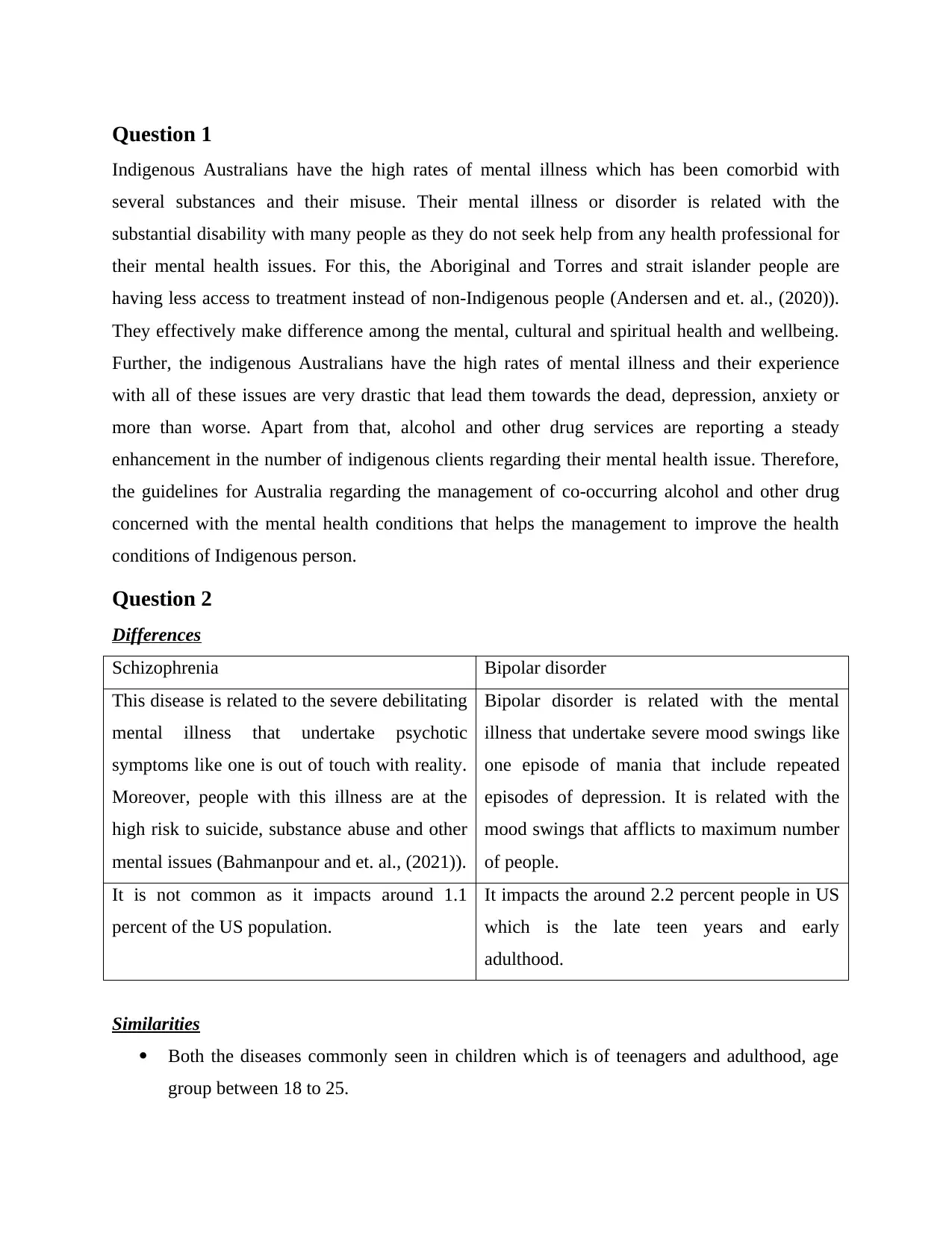
Question 1
Indigenous Australians have the high rates of mental illness which has been comorbid with
several substances and their misuse. Their mental illness or disorder is related with the
substantial disability with many people as they do not seek help from any health professional for
their mental health issues. For this, the Aboriginal and Torres and strait islander people are
having less access to treatment instead of non-Indigenous people (Andersen and et. al., (2020)).
They effectively make difference among the mental, cultural and spiritual health and wellbeing.
Further, the indigenous Australians have the high rates of mental illness and their experience
with all of these issues are very drastic that lead them towards the dead, depression, anxiety or
more than worse. Apart from that, alcohol and other drug services are reporting a steady
enhancement in the number of indigenous clients regarding their mental health issue. Therefore,
the guidelines for Australia regarding the management of co-occurring alcohol and other drug
concerned with the mental health conditions that helps the management to improve the health
conditions of Indigenous person.
Question 2
Differences
Schizophrenia Bipolar disorder
This disease is related to the severe debilitating
mental illness that undertake psychotic
symptoms like one is out of touch with reality.
Moreover, people with this illness are at the
high risk to suicide, substance abuse and other
mental issues (Bahmanpour and et. al., (2021)).
Bipolar disorder is related with the mental
illness that undertake severe mood swings like
one episode of mania that include repeated
episodes of depression. It is related with the
mood swings that afflicts to maximum number
of people.
It is not common as it impacts around 1.1
percent of the US population.
It impacts the around 2.2 percent people in US
which is the late teen years and early
adulthood.
Similarities
Both the diseases commonly seen in children which is of teenagers and adulthood, age
group between 18 to 25.
Indigenous Australians have the high rates of mental illness which has been comorbid with
several substances and their misuse. Their mental illness or disorder is related with the
substantial disability with many people as they do not seek help from any health professional for
their mental health issues. For this, the Aboriginal and Torres and strait islander people are
having less access to treatment instead of non-Indigenous people (Andersen and et. al., (2020)).
They effectively make difference among the mental, cultural and spiritual health and wellbeing.
Further, the indigenous Australians have the high rates of mental illness and their experience
with all of these issues are very drastic that lead them towards the dead, depression, anxiety or
more than worse. Apart from that, alcohol and other drug services are reporting a steady
enhancement in the number of indigenous clients regarding their mental health issue. Therefore,
the guidelines for Australia regarding the management of co-occurring alcohol and other drug
concerned with the mental health conditions that helps the management to improve the health
conditions of Indigenous person.
Question 2
Differences
Schizophrenia Bipolar disorder
This disease is related to the severe debilitating
mental illness that undertake psychotic
symptoms like one is out of touch with reality.
Moreover, people with this illness are at the
high risk to suicide, substance abuse and other
mental issues (Bahmanpour and et. al., (2021)).
Bipolar disorder is related with the mental
illness that undertake severe mood swings like
one episode of mania that include repeated
episodes of depression. It is related with the
mood swings that afflicts to maximum number
of people.
It is not common as it impacts around 1.1
percent of the US population.
It impacts the around 2.2 percent people in US
which is the late teen years and early
adulthood.
Similarities
Both the diseases commonly seen in children which is of teenagers and adulthood, age
group between 18 to 25.
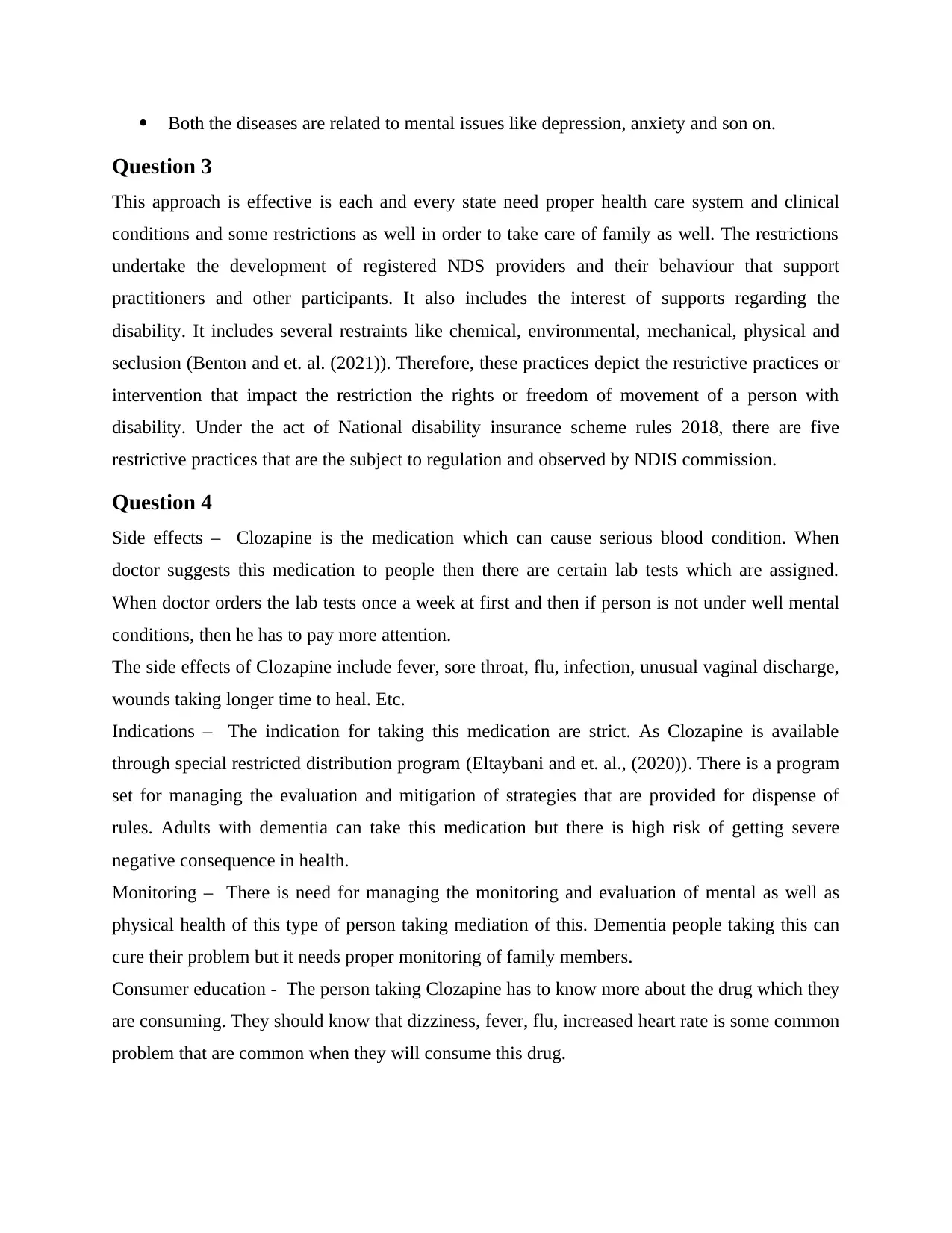
Both the diseases are related to mental issues like depression, anxiety and son on.
Question 3
This approach is effective is each and every state need proper health care system and clinical
conditions and some restrictions as well in order to take care of family as well. The restrictions
undertake the development of registered NDS providers and their behaviour that support
practitioners and other participants. It also includes the interest of supports regarding the
disability. It includes several restraints like chemical, environmental, mechanical, physical and
seclusion (Benton and et. al. (2021)). Therefore, these practices depict the restrictive practices or
intervention that impact the restriction the rights or freedom of movement of a person with
disability. Under the act of National disability insurance scheme rules 2018, there are five
restrictive practices that are the subject to regulation and observed by NDIS commission.
Question 4
Side effects – Clozapine is the medication which can cause serious blood condition. When
doctor suggests this medication to people then there are certain lab tests which are assigned.
When doctor orders the lab tests once a week at first and then if person is not under well mental
conditions, then he has to pay more attention.
The side effects of Clozapine include fever, sore throat, flu, infection, unusual vaginal discharge,
wounds taking longer time to heal. Etc.
Indications – The indication for taking this medication are strict. As Clozapine is available
through special restricted distribution program (Eltaybani and et. al., (2020)). There is a program
set for managing the evaluation and mitigation of strategies that are provided for dispense of
rules. Adults with dementia can take this medication but there is high risk of getting severe
negative consequence in health.
Monitoring – There is need for managing the monitoring and evaluation of mental as well as
physical health of this type of person taking mediation of this. Dementia people taking this can
cure their problem but it needs proper monitoring of family members.
Consumer education - The person taking Clozapine has to know more about the drug which they
are consuming. They should know that dizziness, fever, flu, increased heart rate is some common
problem that are common when they will consume this drug.
Question 3
This approach is effective is each and every state need proper health care system and clinical
conditions and some restrictions as well in order to take care of family as well. The restrictions
undertake the development of registered NDS providers and their behaviour that support
practitioners and other participants. It also includes the interest of supports regarding the
disability. It includes several restraints like chemical, environmental, mechanical, physical and
seclusion (Benton and et. al. (2021)). Therefore, these practices depict the restrictive practices or
intervention that impact the restriction the rights or freedom of movement of a person with
disability. Under the act of National disability insurance scheme rules 2018, there are five
restrictive practices that are the subject to regulation and observed by NDIS commission.
Question 4
Side effects – Clozapine is the medication which can cause serious blood condition. When
doctor suggests this medication to people then there are certain lab tests which are assigned.
When doctor orders the lab tests once a week at first and then if person is not under well mental
conditions, then he has to pay more attention.
The side effects of Clozapine include fever, sore throat, flu, infection, unusual vaginal discharge,
wounds taking longer time to heal. Etc.
Indications – The indication for taking this medication are strict. As Clozapine is available
through special restricted distribution program (Eltaybani and et. al., (2020)). There is a program
set for managing the evaluation and mitigation of strategies that are provided for dispense of
rules. Adults with dementia can take this medication but there is high risk of getting severe
negative consequence in health.
Monitoring – There is need for managing the monitoring and evaluation of mental as well as
physical health of this type of person taking mediation of this. Dementia people taking this can
cure their problem but it needs proper monitoring of family members.
Consumer education - The person taking Clozapine has to know more about the drug which they
are consuming. They should know that dizziness, fever, flu, increased heart rate is some common
problem that are common when they will consume this drug.
⊘ This is a preview!⊘
Do you want full access?
Subscribe today to unlock all pages.

Trusted by 1+ million students worldwide
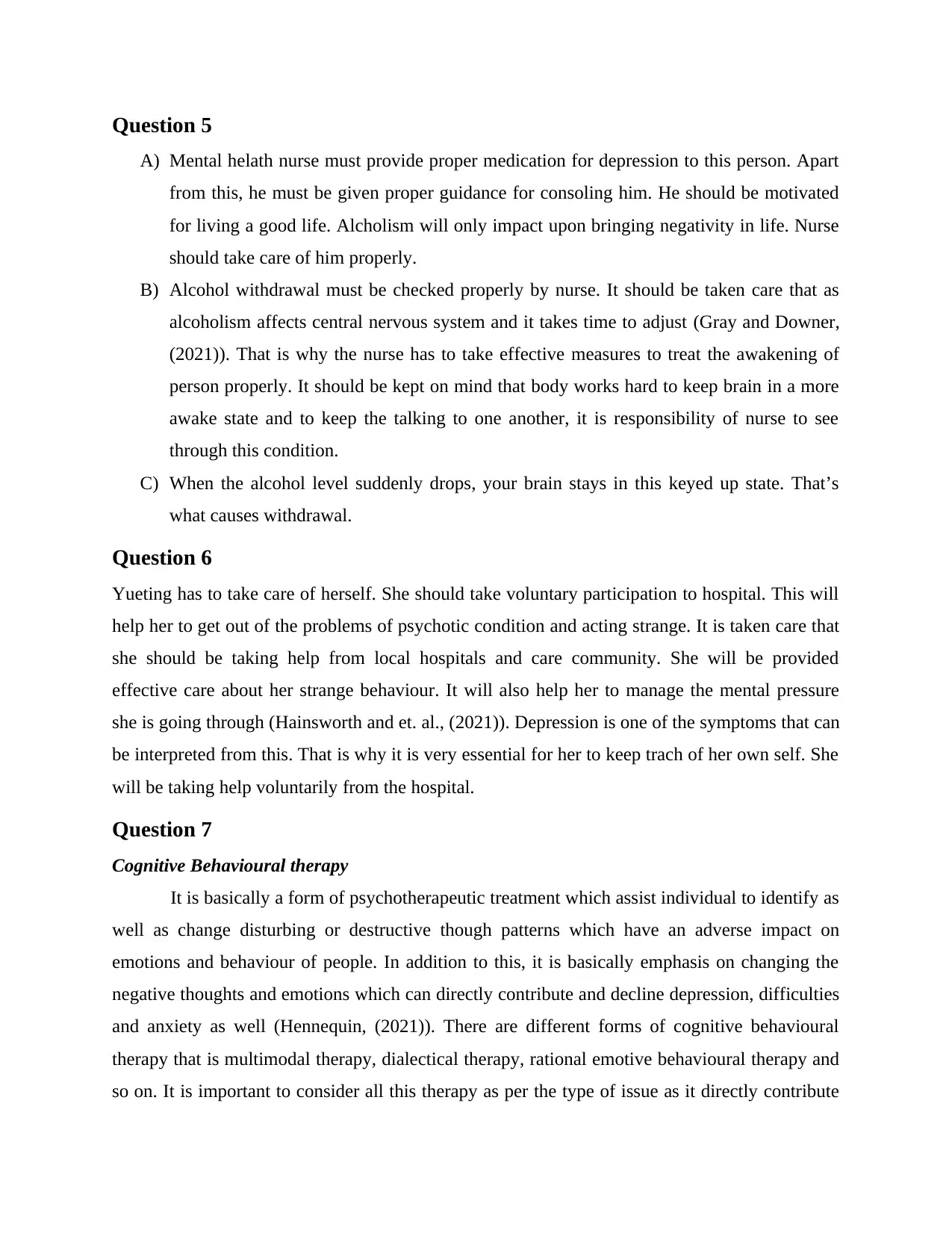
Question 5
A) Mental helath nurse must provide proper medication for depression to this person. Apart
from this, he must be given proper guidance for consoling him. He should be motivated
for living a good life. Alcholism will only impact upon bringing negativity in life. Nurse
should take care of him properly.
B) Alcohol withdrawal must be checked properly by nurse. It should be taken care that as
alcoholism affects central nervous system and it takes time to adjust (Gray and Downer,
(2021)). That is why the nurse has to take effective measures to treat the awakening of
person properly. It should be kept on mind that body works hard to keep brain in a more
awake state and to keep the talking to one another, it is responsibility of nurse to see
through this condition.
C) When the alcohol level suddenly drops, your brain stays in this keyed up state. That’s
what causes withdrawal.
Question 6
Yueting has to take care of herself. She should take voluntary participation to hospital. This will
help her to get out of the problems of psychotic condition and acting strange. It is taken care that
she should be taking help from local hospitals and care community. She will be provided
effective care about her strange behaviour. It will also help her to manage the mental pressure
she is going through (Hainsworth and et. al., (2021)). Depression is one of the symptoms that can
be interpreted from this. That is why it is very essential for her to keep trach of her own self. She
will be taking help voluntarily from the hospital.
Question 7
Cognitive Behavioural therapy
It is basically a form of psychotherapeutic treatment which assist individual to identify as
well as change disturbing or destructive though patterns which have an adverse impact on
emotions and behaviour of people. In addition to this, it is basically emphasis on changing the
negative thoughts and emotions which can directly contribute and decline depression, difficulties
and anxiety as well (Hennequin, (2021)). There are different forms of cognitive behavioural
therapy that is multimodal therapy, dialectical therapy, rational emotive behavioural therapy and
so on. It is important to consider all this therapy as per the type of issue as it directly contribute
A) Mental helath nurse must provide proper medication for depression to this person. Apart
from this, he must be given proper guidance for consoling him. He should be motivated
for living a good life. Alcholism will only impact upon bringing negativity in life. Nurse
should take care of him properly.
B) Alcohol withdrawal must be checked properly by nurse. It should be taken care that as
alcoholism affects central nervous system and it takes time to adjust (Gray and Downer,
(2021)). That is why the nurse has to take effective measures to treat the awakening of
person properly. It should be kept on mind that body works hard to keep brain in a more
awake state and to keep the talking to one another, it is responsibility of nurse to see
through this condition.
C) When the alcohol level suddenly drops, your brain stays in this keyed up state. That’s
what causes withdrawal.
Question 6
Yueting has to take care of herself. She should take voluntary participation to hospital. This will
help her to get out of the problems of psychotic condition and acting strange. It is taken care that
she should be taking help from local hospitals and care community. She will be provided
effective care about her strange behaviour. It will also help her to manage the mental pressure
she is going through (Hainsworth and et. al., (2021)). Depression is one of the symptoms that can
be interpreted from this. That is why it is very essential for her to keep trach of her own self. She
will be taking help voluntarily from the hospital.
Question 7
Cognitive Behavioural therapy
It is basically a form of psychotherapeutic treatment which assist individual to identify as
well as change disturbing or destructive though patterns which have an adverse impact on
emotions and behaviour of people. In addition to this, it is basically emphasis on changing the
negative thoughts and emotions which can directly contribute and decline depression, difficulties
and anxiety as well (Hennequin, (2021)). There are different forms of cognitive behavioural
therapy that is multimodal therapy, dialectical therapy, rational emotive behavioural therapy and
so on. It is important to consider all this therapy as per the type of issue as it directly contribute
Paraphrase This Document
Need a fresh take? Get an instant paraphrase of this document with our AI Paraphraser

towards the psychological distress. Apart from this, it is analysed that such theory directly
encompasses a various range of approaches as well as techniques which address emotions,
thoughts and behaviours. All these range a number of particular forms of therapeutic approaches.
Hypnotherapy
Hypnotherapy is the adjunct technique that is based on utilising of the hypnosis that can aid in
the processes of treatment of some health conditions or specific symptoms. It is regarded as part
of treatment plan of anxiety disorder or some sort pf phobias that may affect an individual, it is
also adopted in some instances for pain management, smoking cessation, weight loss and other
such application (Leighton and et. al., (2021)). Hypnotherapy generally is sued for the purpose of
inducing of hypnotic stage that is marked by waking of awareness among the patients, it allows
people to experience a detached external detonation and further focus on some sort of inner
experiences in course of their treatment.
Question 8
In context to the assessment of Perry mood four important questions which should ask to perry is
given below.
Within past two weeks how many times have felt down, depresses or helpless?
Have you faced the thought of self-harm or suicide?
How is your sleeping, from last 2 weeks and sleeping hours?
Geriatric depression scale, do you prefer to stay at the home rather than going out side?
These questions should ask to the patient because depression isn't the same periods of feeling
down, these questions asked to the patient while screening for depression, in order to identify the
symptoms of depression that how may symptoms of depression possess by the patient. This helps
to understand that how longer they are existing and how much they have affected the normal life
of the patient. By the aid of these questions that will become easy to understand the specific
reason of the patient depression, that what are the environmental and biological factors of the
depression by evaluating the symptoms through these questions. This is the important first step
of the in order to help the patient come out of the depression. The honest answers of the patient
will help to effectively develop the care plan and interventions for patient.
encompasses a various range of approaches as well as techniques which address emotions,
thoughts and behaviours. All these range a number of particular forms of therapeutic approaches.
Hypnotherapy
Hypnotherapy is the adjunct technique that is based on utilising of the hypnosis that can aid in
the processes of treatment of some health conditions or specific symptoms. It is regarded as part
of treatment plan of anxiety disorder or some sort pf phobias that may affect an individual, it is
also adopted in some instances for pain management, smoking cessation, weight loss and other
such application (Leighton and et. al., (2021)). Hypnotherapy generally is sued for the purpose of
inducing of hypnotic stage that is marked by waking of awareness among the patients, it allows
people to experience a detached external detonation and further focus on some sort of inner
experiences in course of their treatment.
Question 8
In context to the assessment of Perry mood four important questions which should ask to perry is
given below.
Within past two weeks how many times have felt down, depresses or helpless?
Have you faced the thought of self-harm or suicide?
How is your sleeping, from last 2 weeks and sleeping hours?
Geriatric depression scale, do you prefer to stay at the home rather than going out side?
These questions should ask to the patient because depression isn't the same periods of feeling
down, these questions asked to the patient while screening for depression, in order to identify the
symptoms of depression that how may symptoms of depression possess by the patient. This helps
to understand that how longer they are existing and how much they have affected the normal life
of the patient. By the aid of these questions that will become easy to understand the specific
reason of the patient depression, that what are the environmental and biological factors of the
depression by evaluating the symptoms through these questions. This is the important first step
of the in order to help the patient come out of the depression. The honest answers of the patient
will help to effectively develop the care plan and interventions for patient.
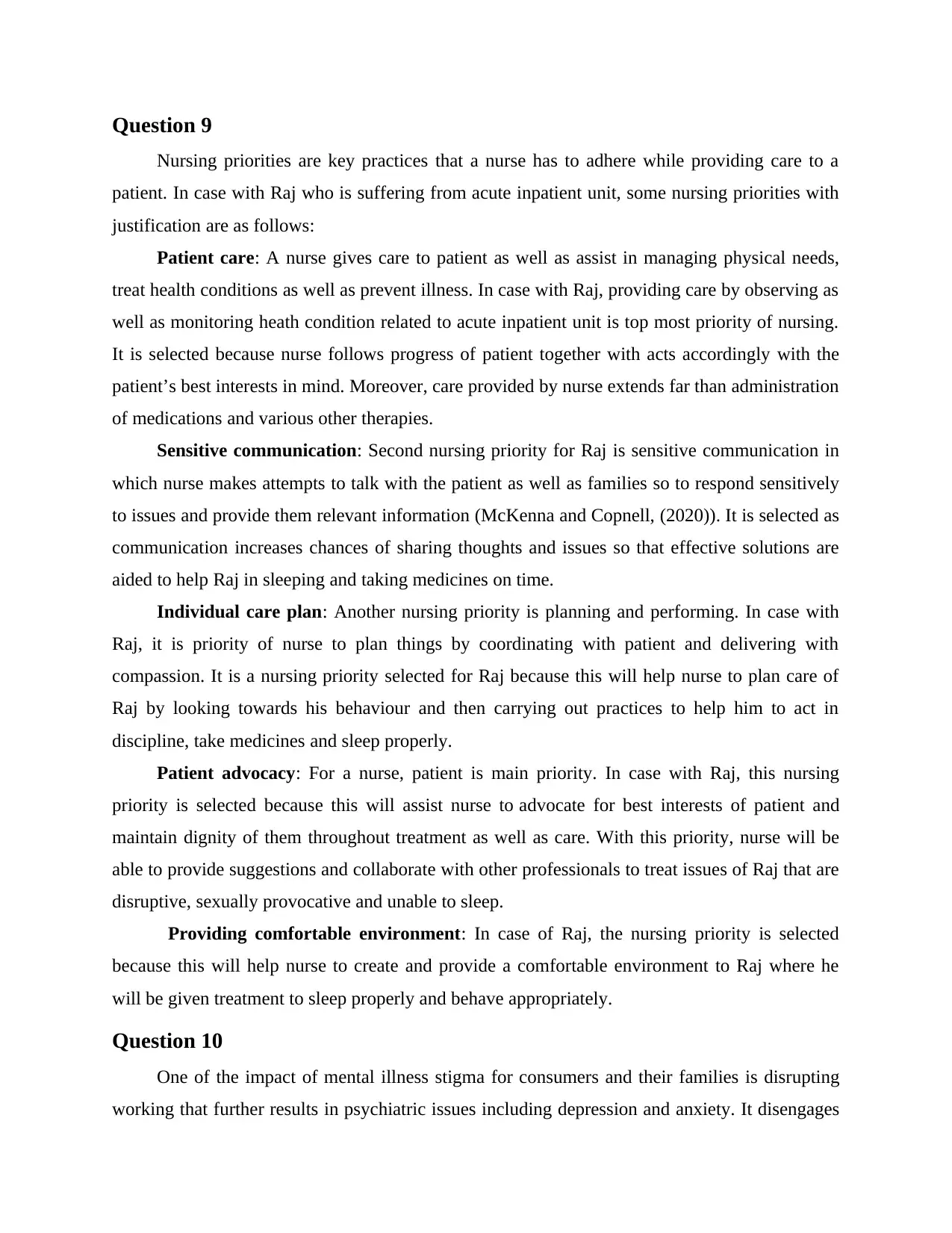
Question 9
Nursing priorities are key practices that a nurse has to adhere while providing care to a
patient. In case with Raj who is suffering from acute inpatient unit, some nursing priorities with
justification are as follows:
Patient care: A nurse gives care to patient as well as assist in managing physical needs,
treat health conditions as well as prevent illness. In case with Raj, providing care by observing as
well as monitoring heath condition related to acute inpatient unit is top most priority of nursing.
It is selected because nurse follows progress of patient together with acts accordingly with the
patient’s best interests in mind. Moreover, care provided by nurse extends far than administration
of medications and various other therapies.
Sensitive communication: Second nursing priority for Raj is sensitive communication in
which nurse makes attempts to talk with the patient as well as families so to respond sensitively
to issues and provide them relevant information (McKenna and Copnell, (2020)). It is selected as
communication increases chances of sharing thoughts and issues so that effective solutions are
aided to help Raj in sleeping and taking medicines on time.
Individual care plan: Another nursing priority is planning and performing. In case with
Raj, it is priority of nurse to plan things by coordinating with patient and delivering with
compassion. It is a nursing priority selected for Raj because this will help nurse to plan care of
Raj by looking towards his behaviour and then carrying out practices to help him to act in
discipline, take medicines and sleep properly.
Patient advocacy: For a nurse, patient is main priority. In case with Raj, this nursing
priority is selected because this will assist nurse to advocate for best interests of patient and
maintain dignity of them throughout treatment as well as care. With this priority, nurse will be
able to provide suggestions and collaborate with other professionals to treat issues of Raj that are
disruptive, sexually provocative and unable to sleep.
Providing comfortable environment: In case of Raj, the nursing priority is selected
because this will help nurse to create and provide a comfortable environment to Raj where he
will be given treatment to sleep properly and behave appropriately.
Question 10
One of the impact of mental illness stigma for consumers and their families is disrupting
working that further results in psychiatric issues including depression and anxiety. It disengages
Nursing priorities are key practices that a nurse has to adhere while providing care to a
patient. In case with Raj who is suffering from acute inpatient unit, some nursing priorities with
justification are as follows:
Patient care: A nurse gives care to patient as well as assist in managing physical needs,
treat health conditions as well as prevent illness. In case with Raj, providing care by observing as
well as monitoring heath condition related to acute inpatient unit is top most priority of nursing.
It is selected because nurse follows progress of patient together with acts accordingly with the
patient’s best interests in mind. Moreover, care provided by nurse extends far than administration
of medications and various other therapies.
Sensitive communication: Second nursing priority for Raj is sensitive communication in
which nurse makes attempts to talk with the patient as well as families so to respond sensitively
to issues and provide them relevant information (McKenna and Copnell, (2020)). It is selected as
communication increases chances of sharing thoughts and issues so that effective solutions are
aided to help Raj in sleeping and taking medicines on time.
Individual care plan: Another nursing priority is planning and performing. In case with
Raj, it is priority of nurse to plan things by coordinating with patient and delivering with
compassion. It is a nursing priority selected for Raj because this will help nurse to plan care of
Raj by looking towards his behaviour and then carrying out practices to help him to act in
discipline, take medicines and sleep properly.
Patient advocacy: For a nurse, patient is main priority. In case with Raj, this nursing
priority is selected because this will assist nurse to advocate for best interests of patient and
maintain dignity of them throughout treatment as well as care. With this priority, nurse will be
able to provide suggestions and collaborate with other professionals to treat issues of Raj that are
disruptive, sexually provocative and unable to sleep.
Providing comfortable environment: In case of Raj, the nursing priority is selected
because this will help nurse to create and provide a comfortable environment to Raj where he
will be given treatment to sleep properly and behave appropriately.
Question 10
One of the impact of mental illness stigma for consumers and their families is disrupting
working that further results in psychiatric issues including depression and anxiety. It disengages
⊘ This is a preview!⊘
Do you want full access?
Subscribe today to unlock all pages.

Trusted by 1+ million students worldwide

people from services and stop them to take medication which causes relapse as well as hinder
recovery among people and restrict family members to communicate with others in society.
Another impact of mental illness stigma for consumers and their families is chronic disease
(Reeves and O’Shea, (2020)). In consumers and their families, mental illness stigma causes
serious disease as well as health conditions such as hypertension and stroke. It damages self-
esteem, difficulty to work on a job, reluctance to admit illness and difficulty in making and
keeping friends.
recovery among people and restrict family members to communicate with others in society.
Another impact of mental illness stigma for consumers and their families is chronic disease
(Reeves and O’Shea, (2020)). In consumers and their families, mental illness stigma causes
serious disease as well as health conditions such as hypertension and stroke. It damages self-
esteem, difficulty to work on a job, reluctance to admit illness and difficulty in making and
keeping friends.
Paraphrase This Document
Need a fresh take? Get an instant paraphrase of this document with our AI Paraphraser

REFERENCES
Books and Journals
Andersen, P., Downer, T., Spencer, A., & Willcocks, K. (2020). Using observational simulation
teaching methods in professional development to address patient safety. Collegian,
27(2), 207-212.
Bahmanpour, K., Nemati, S. M., Lantta, T., Gheshlagh, R. G., & Valiee, S. (2021). Development
and preliminary psychometric evaluation of a nursing error tool in critical care units.
Intensive and Critical Care Nursing, 103079.
Benton, D., Ferguson, S., & Del Pulgar, M. G. (2021). Exploring the influence of the nursing
and medical professions on policy and politics. Nursing Management, 28(2).
Eltaybani, S., Igarashi, A., & Yamamoto-Mitani, N. (2020). Palliative and end-of-life care in
Egypt: overview and recommendations for improvement. International journal of
palliative nursing, 26(6), 284-291.
Gray, M., & Downer, T. (2021). Midwives’ perspectives of the challenges in mentoring students:
a qualitative survey. Collegian, 28(1), 135-142.
Hainsworth, N., Dowse, E., Ebert, L., & Foureur, M. (2021). ‘Continuity of Care Experiences’
within pre-registration midwifery education programs: A scoping review. Women and
Birth.
Hennequin, C. M. (2021). Evaluating the Effectiveness of Frameworks Benchmarking for
Quality Spiritual Care in Victoria, Australia. Health and Social Care Chaplaincy, 9(2),
278-297.
Leighton, K., Kardong-Edgren, S., McNelis, A. M., Foisy-Doll, C., & Sullo, E. (2021).
Traditional clinical outcomes in prelicensure nursing education: an empty systematic
review. Journal of Nursing Education, 60(3), 136-142.
McKenna, L., & Copnell, B. (2020). Fundamentals of Nursing and Midwifery Research: A
practical guide for evidence-based practice. Routledge.
Reeves, N. E., & O’Shea, M. C. (2020). Simulation in Exercise Science and Physiology—No
Longer a Luxury but a Necessity. Journal of Clinical Exercise Physiology, 9(2), 83-88.
Books and Journals
Andersen, P., Downer, T., Spencer, A., & Willcocks, K. (2020). Using observational simulation
teaching methods in professional development to address patient safety. Collegian,
27(2), 207-212.
Bahmanpour, K., Nemati, S. M., Lantta, T., Gheshlagh, R. G., & Valiee, S. (2021). Development
and preliminary psychometric evaluation of a nursing error tool in critical care units.
Intensive and Critical Care Nursing, 103079.
Benton, D., Ferguson, S., & Del Pulgar, M. G. (2021). Exploring the influence of the nursing
and medical professions on policy and politics. Nursing Management, 28(2).
Eltaybani, S., Igarashi, A., & Yamamoto-Mitani, N. (2020). Palliative and end-of-life care in
Egypt: overview and recommendations for improvement. International journal of
palliative nursing, 26(6), 284-291.
Gray, M., & Downer, T. (2021). Midwives’ perspectives of the challenges in mentoring students:
a qualitative survey. Collegian, 28(1), 135-142.
Hainsworth, N., Dowse, E., Ebert, L., & Foureur, M. (2021). ‘Continuity of Care Experiences’
within pre-registration midwifery education programs: A scoping review. Women and
Birth.
Hennequin, C. M. (2021). Evaluating the Effectiveness of Frameworks Benchmarking for
Quality Spiritual Care in Victoria, Australia. Health and Social Care Chaplaincy, 9(2),
278-297.
Leighton, K., Kardong-Edgren, S., McNelis, A. M., Foisy-Doll, C., & Sullo, E. (2021).
Traditional clinical outcomes in prelicensure nursing education: an empty systematic
review. Journal of Nursing Education, 60(3), 136-142.
McKenna, L., & Copnell, B. (2020). Fundamentals of Nursing and Midwifery Research: A
practical guide for evidence-based practice. Routledge.
Reeves, N. E., & O’Shea, M. C. (2020). Simulation in Exercise Science and Physiology—No
Longer a Luxury but a Necessity. Journal of Clinical Exercise Physiology, 9(2), 83-88.
1 out of 8
Related Documents
Your All-in-One AI-Powered Toolkit for Academic Success.
+13062052269
info@desklib.com
Available 24*7 on WhatsApp / Email
![[object Object]](/_next/static/media/star-bottom.7253800d.svg)
Unlock your academic potential
Copyright © 2020–2026 A2Z Services. All Rights Reserved. Developed and managed by ZUCOL.





